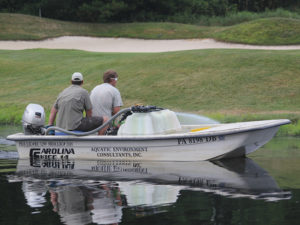
Seine Sampling by AEC
Aquatic Environment Consultants (AEC) has been providing seine sampling and other fish population management services since 1987. Covering a large geographic territory in the Midwest and Mid-Atlantic regions, we are able to offer on-site service to lakes and ponds of any size.
Our highly skilled technicians are available to perform seine netting for aquaculture operations, private properties and other facilities. Working quickly to minimize disruption to your lake and its ecosystem, we’ll collect important information that lets us help you make informed decisions about the utilization of your fish stocks.
What Is Seine Sampling?
Humans have been using seines to catch fish for thousands of years. At its most primitive, seine sampling is simply the process of dragging a large mesh net across an area of water and documenting the catch. The specifics of your lake or pond will determine the best way to go about seine sampling. In most cases though, it should be done in multiple shallow areas to provide a more comprehensive picture of the condition and health of your fishery.
A sampling seine consists of a floating line and a sunken lead line, with a fine mesh net placed between. This net is dragged either by a boat or by a technician in the water. The size of its mesh will be determined by the type of fish you are trying to catch.
Seine sampling is best for documenting smaller species, such as bass, crappie and bluegill. Larger fish, such as catfish, are more likely to break free or avoid the seine altogether.
What Is Seine Sampling Used For?
Seine sampling serves a number of important purposes in fishery management, such as:
- Identifying the composition of a fishery. Seine sampling provides both direct and indirect confirmation of the presence of fish in your lake or pond. For example, a seine sample that contains high numbers of tadpoles and insects will indicate low levels of the fish that prey on them, such as bream and largemouth bass.
- Documenting the reproductive success of certain fish. During the early summer months, a seine sample that uncovers large numbers of juvenile fish indicates a strong population. Smaller numbers or less healthy juveniles can indicate a problem with species viability.
- Monitoring the effect of environmental changes over time. Seine sampling shouldn’t be a one-time process. Once a baseline for a healthy fish population has been established, periodic sampling provides an effective way of monitoring changes and taking proactive steps when necessary.
Alternatives to Seine Sampling
While seine sampling has a number of benefits, it isn’t the right choice for every pond or lake. In environments filed with cattails or other dense plant species, or in areas with too many tree stumps or logs, seine sampling isn’t generally an option. It also can’t be performed in deep or fast-moving waters.
AEC offers several alternatives to seine sampling for fisheries management, including electrofishing, gill netting and trap netting. During your initial consultation with our expert technicians, we’ll review a number of factors to determine which is the best choice for your lake or pond.
For more information or to book an appointment, contact AEC directly by phone or email.
